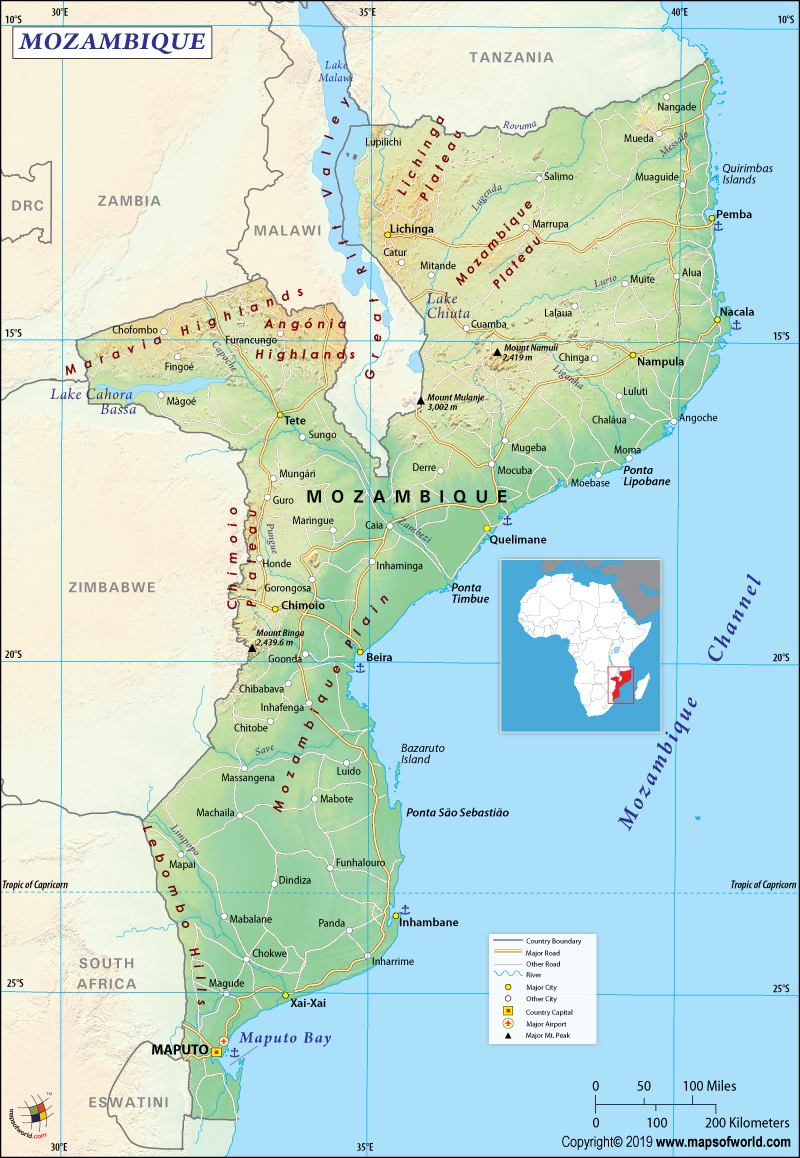

Map of Mozambique
| Official Name | Republic of Mozambique |
| Continent | Africa |
| Capital | Maputo |
| Largest City | Matola |
| Coordinates | -18.250000, 35.000000 |
| Area | 309,500 sq mi ( 801,590 sq km) |
| Land Boundaries | 2,840 mi ( 4,571 km) |
| Coastline | 1,535 mi ( 2,470 km) |
| Currency | Mozambican metical (MZN) |
| Neighboring Countries | Tanzania, Malawi, Zambia, Zimbabwe, South Africa, eSwatini |
| Population | 28,829,476 (2016 est.) |
| Official Languages | Portuguese |
| Major Religion | Christianity |
| National Day | 25 June, Independence from Portugal |
| National Anthem | “Patria Amada” |
| Form of Government | Unitary presidential constitutional republic |
| President | Filipe Nyusi |
| Prime Minister | Carlos Agostinho do Rosário |
| GDP per capita (PPP) | $1,250.2 (World Bank, 2017) |
| GDP per capita (nominal) | $426.2 (World Bank, 2017) |
| HDI | 0.437 (2017), Rank: 180 |
| Literacy Rate | 56.04 (UNESCO, 2015) |
| Space Agency | NA |
| Military Expenditure Ranking | 118 (SIPRI, 2017) |
| No. of Olympic Medals | 2 (as of 2018) |
| Driving Side | Left |
| Calling Code | +258 |
| Time Zone | UTC+2 (CAT) |
| Internet TLD | .mz |
Mozambique is a Southeast African country that shares land borders with six countries (Tanzania to the north, Zimbabwe to the west, Malawi and Zambia to the northwest, and Eswatini and South Africa to the southwest) and the Indian Ocean to the east.
Mozambique’s physical geography mostly consists of coastal lowlands, uplands in the central part, and high plateaus in the northwest part. The western position also consists of mountains. Two topographical regions of the country include:
Here is Mozambique Physical Map showing all physical feature of the country.
The lowest elevation point of Mozambique touches sea level, the highest point is Monte Binga peak 7,988 feet (2,435 meters). The major mountains of Mozambique are Binga, Namuli, Currarre, Serra Chiperone, Panga, Serra Nhatoa, Mepulo, Zombue, Nhandore, and Gorungue. The most summited peak in the country is Monte Chimanimani (3,328 feet or 1,015 meters).
Mozambique has five major rivers (largest being Zambezi) along with several smaller ones. The major lakes of the country are Lake Malawi (Nyasa), Lake Chiuta, Lake Shirwa, and Lake Cahora Bassa (4th largest artificial lake of Africa). The climate of Mozambique is tropical in nature and the coastline is highly influenced by the Indian Ocean monsoon rains.
Mozambique has a tropical climate, but the climatic conditions change due to variation of altitude. While the influence is strongest in the northeast part of the country, the island barriers of Madagascar, Seychelles, and Comoros somewhat modify the influence. Overall, there are two prominent seasons in Mozambique:
October-to-March is the wet season, during which cyclones are common. Due to the devastating Idai and Kenneth cyclones in 2019, the country suffered heavily due to floods and destruction. April-to-September is the dry season.
Heavy rainfall takes place along the coastal areas and decreases as you move towards the north and the south. While average precipitation is 590 mm (or 23.2 inches), the annual level of precipitation varies from 500-to-900 mm (or 19.7-to-35.4 inches).
In Maputo (capital of the country), average temperature varies from 13-to-24 °C in July, to 22-to-31 °C in February.
Having suffered four centuries of colonial rule under the Portuguese, Mozambique is one of the most underdeveloped and poorest countries of the world. The 2017 estimated nominal GDP of the country is just US$12.35 billion. Most of the labor force is still dependent upon agriculture (77%). Only 23% of the labor force works in the services (15%) and industrial sectors (8%).
50% of the population is reeling under poverty and the unemployment rate was hovering between 22.55% in 2012 and 25.30% in 2014. In 2017, the unemployment rate was 25.04%. The major export items are prawns, cotton, sugar, copra, cashew nuts, timber, coconuts, and citrus. Major import items of Mozambique are petroleum products, clothes, and foods.
Though the Mozambican economy grew by 7% during 2011-2015, the estimated GDP growth has come down to 3.3% in 2018. The economy suffered a hidden debt crisis in 2016. However, the economic indicators are slowly getting better. The external debt to GDP has come down from 103.7% at 2016-end to estimated 85.2% at 2017-end. The GDP is expected to grow by 4% in 2019.
The major modes of transport are railways, highways, waterways, sea transport, and airways.
WTO, IMF, ACP, ILO, AfDB, UNCTAD, UNESCO, AU, WHO, C, CD, UN, UNHCR, UNIDO, Union Latina, CPLP, Interpol, EITI (compliant country), FAO, G-77, IAEA, IBRD, ICAO, ICC (NGOs), ICRM, IDA, IDB, IFAD, IFC, IFRCS, IHO, IMO, IMSO, IOC, IOM, IPU, ISO (correspondent), ITSO, ITU, ITUC (NGOs), MIGA, NAM, OIC, OIF (observer), OPCW, SADC, UNISFA, UNWTO, UPU, WCO, WFTU (NGOs), WIPO, WMO.
The Republic of Madagascar is an island country located in the Indian Ocean, off the…
The Euro is the official currency of the European Union. It is, however, not incumbent…
There are many countries or regions that are partially recognized by the UN, have disputes…
The Alaska Statehood Act was signed into law by President Dwight D. Eisenhower in 1958,…
The name Persia may, however, only be used to refer to Iran in some contexts.…
Hawaii is an Island State in the US. It is one of the 50 states…